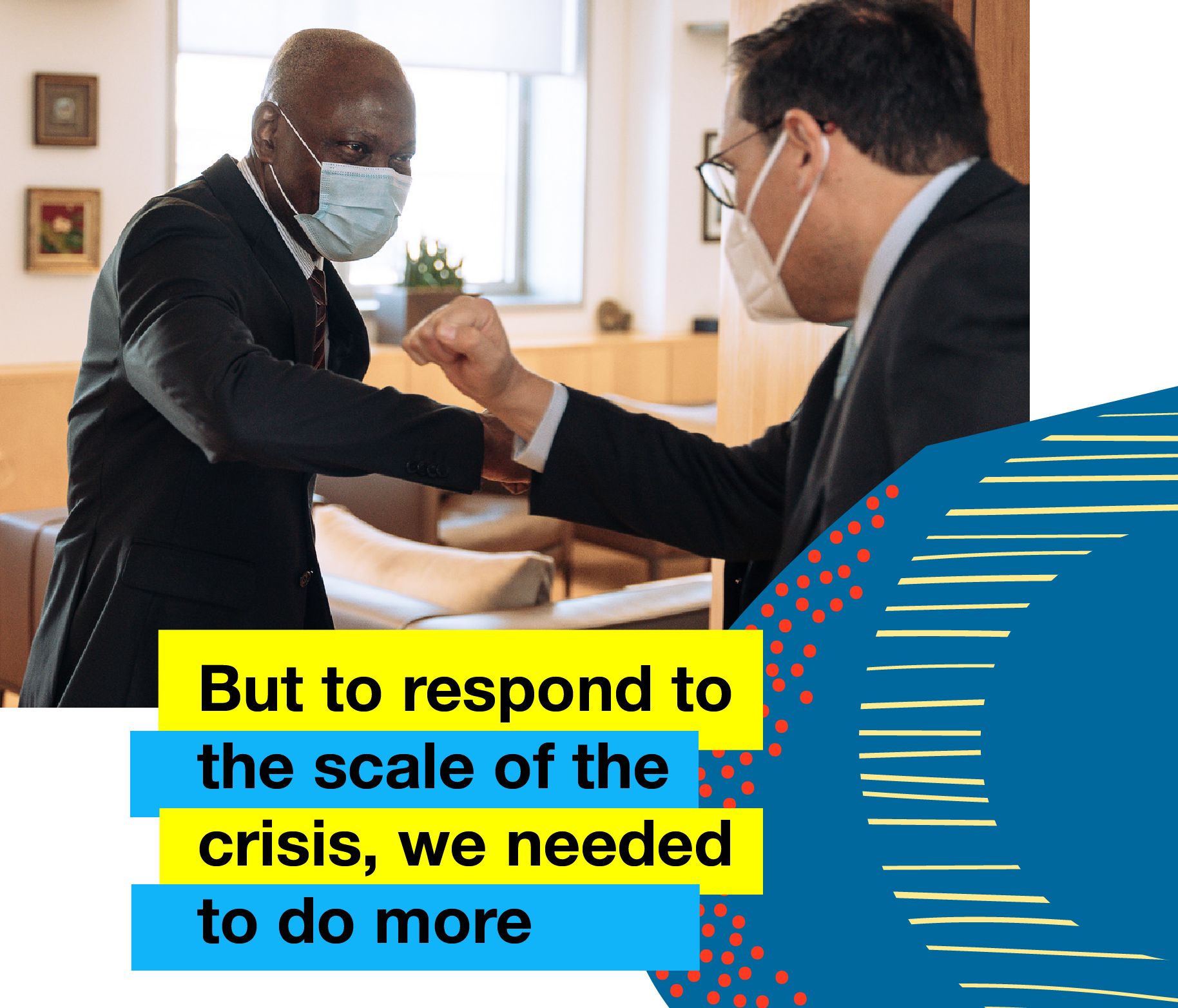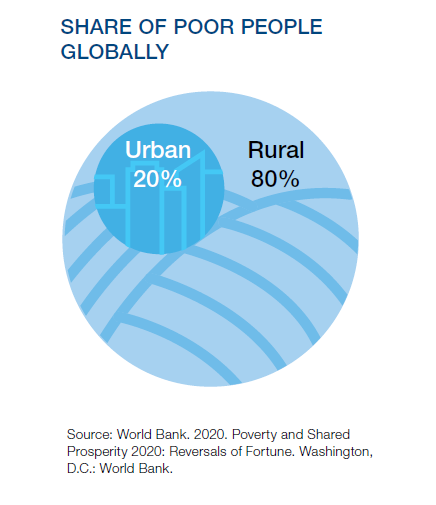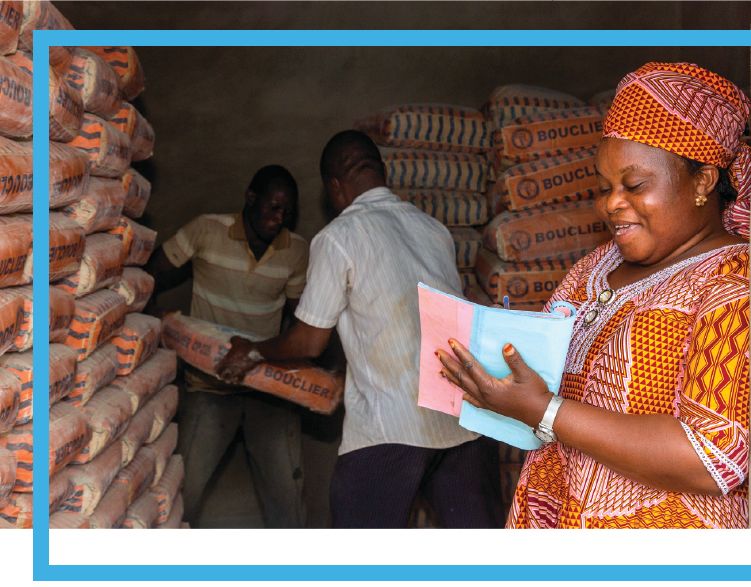IFAD Annual Report 2020

2020 was a year in which rural people faced unprecedented challenges.
Already coping with the impacts of climate change, environmental pressures, pest and disease outbreaks, inequality and economic downturns, 2020 brought with it a global pandemic that threatened to disrupt global food systems and significantly roll back years of progress in the fight against poverty and hunger.
This was a situation like no other the world had faced in many decades. We had to act fast and decisively to protect rural livelihoods and keep food systems functioning. At the same time, we could not lose sight of our responsibility, as enshrined in the Sustainable Development Goals (SDGs), to chart a pathway to the long-term food security, poverty reduction, resilience and the inclusive transformation of rural communities.

President's foreword

Responding quickly, but thinking long term
As the pandemic struck, IFAD country teams immediately began working with governments to adjust ongoing projects so rural people could maintain their income-generating activities and not be forced to sell their meagre assets.
Major priorities included ensuring seeds were available for the upcoming planting season, and using digital solutions to help small-scale farmers reach customers and sell their produce. Our first restructured project was in Bosnia and Herzegovina: by the end of March, partnering with the government, we had provided support packages to 9,000 vulnerable households, including seedlings.
But it soon became clear that the scale of the crisis called for us to do more. We needed to partner more with governments to reach more rural people – and support them with timely access to inputs, information, markets and liquidity.
In April we launched the Rural Poor Stimulus Facility (RPSF). IFAD provided US$40 million to kick-start the RPSF and raised over US$50 million through generous contributions from Canada, Germany, the Netherlands, Sweden and Switzerland. As the pandemic continues, the RPSF is supporting rural people to stay on their feet economically and is contributing to the continued availability of food. As more funding and support comes in for the RPSF, we expect to do even more in 2021.
2020 was also about building for the future, ensuring IFAD is in a position to lead the recovery and getting back on track to meet the SDGs, especially to end extreme poverty and hunger. This has meant revamping our financial architecture so we can invest more and reach more rural people – while maintaining financial discipline and managing risks.

Core contributions remain the bedrock of IFAD’s funding. At the same time, our financial credentials have been recognized and the opportunity to mobilize more resources has been enhanced by a strong credit rating obtained during the year, from both Fitch and Standard and Poor’s. Our new integrated borrowing framework will further enable us to manage the risks associated with a more ambitious financial model, and ensure IFAD’s financial sustainability.
Doing more to build the resilience of rural people does not only mean scaling up investments – it also means going further to reach the people most likely to be left behind.
In 2020, among important initiatives were our revised targeting guidelines. These guidelines will ensure that the principle of leaving no one behind guides all of IFAD’s operational activities. We also expanded our partnerships with indigenous peoples – more than 10 times as many indigenous peoples’ groups participated in the preparations for IFAD’s Fifth Global Meeting of the Indigenous Peoples’ Forum.
In 2020, we also piloted approaches for greater inclusion of persons with disabilities in IFAD-supported project. And we started activities in five countries for a “grass-roots approach to connecting youth voices to action”, which will enable us to do even more to include young people in our projects in the years ahead.
2020 saw continued progress in refining IFAD’s business processes, so we can achieve better results faster. We prepared a new policy for regular grants financing, which by early 2021 was under implementation. The new policy will ensure that regular grants achieve greater impact on the ground for rural people, especially by promoting synergies with our other, non-grants-based activities, and by strengthening learning processes.
In addition, we are becoming more efficient in both our lending and our non-lending activities through ongoing decentralization.
In 2020 the share of IFAD staff in the field reached 32 per cent, compared with 10 per cent during the IFAD10 (2016-2018) period. Having more staff on the ground is helping us to do more in terms of partnerships and policy engagement, and it is helping us to translate our global engagement activities into action at the local level. This is ever more important as we prepare for the United Nations Food Systems Summit in 2021. IFAD’s experience and knowledge will provide key inputs into the Summit, and our presence on the ground in rural areas will put us on the front line in implementing the outcomes of the Summit in the years ahead, in coordination with our partners.
Despite the challenges of 2020, we remain convinced that our vision of a world free of poverty and hunger is attainable. To achieve this, the rural women and men IFAD serves need to be better prepared to overcome the challenges they face. And we need to ensure they have the support they need so they can withstand the shocks of today and tomorrow. We will keep striving to do more and to get better at what we do so that, together, we can all make this a reality.
Gilbert F. Houngbo
President of IFAD

©IFAD/Susan Beccio
©IFAD/Susan Beccio

©IFAD/Daniele Bianchi
©IFAD/Daniele Bianchi

©IFAD/Flavio Ianniello
©IFAD/Flavio Ianniello
2020 in numbers

A challenging global context
The impacts of the COVID-19 pandemic have exacerbated challenges in reaching the SDGs.

©IFAD/Mateus Augusto dos Santos Vieira
©IFAD/Mateus Augusto dos Santos Vieira
The year 2020 saw the first increase in global extreme poverty in a generation, while prospects for ending hunger worsened.

The resilience of rural people is being severely tested
The COVID-19 pandemic added to the range of threats affecting rural livelihoods – including the increasingly stark impacts of climate change, environmental degradation, inequality, disempowerment and economic downturns.
Most of the world’s poor and hungry people live in rural areas.
Number of undernourished people in the world

Number of people living in extreme poverty globally

More investment in rural resilience is needed
Though challenges are particularly severe, investments to build the resilience of rural livelihoods remain woefully insufficient.
Climate finance targeting small-scale agriculture


©IFAD/Flavio Ianniello
©IFAD/Flavio Ianniello

©IFAD/unamanews
©IFAD/unamanews

©IFAD/ Bernard Kalu
©IFAD/ Bernard Kalu
But challenges such as the pandemic, climate change, environmental pressures and creating opportunities for young people can all be addressed with the right investments.

Investments in rural people pay rich dividends
Despite the difficulties they face, rural people, with IFAD’s support, are finding solutions to boost their livelihoods and keep local food systems and economies running.
“I am grateful that I could get an interest-free loan, as a poor woman. I could start this business with my skills and knowledge and I’m glad to have been able to pay it forward by employing other women like me.”
“We are very happy to be part of the project, because it has certainly helped a lot in the income of our farmers and has stimulated us to produce more and more.”
“Before I started doing what we learned from the training, things were not well in my life. But after the training so many things have changed. I have been planting maize and soya beans while following good agricultural practices. I have also a dairy cow. I am a member of a village challenge fund, which we have formed to help us make some savings. All this was not possible before the training.”
Addressing the socio-economic impacts of the COVID-19 pandemic
When the pandemic struck early in 2020, IFAD launched the Rural Poor Stimulus Facility, a funding mechanism to help the most vulnerable and marginalized people sustain themselves through the crisis and to accelerate the recovery of rural communities.

We also repurposed funds existing projects to finance the COVID-19 response activities.

Doubling our impact
Recovering from the COVID-19 pandemic, building resilience to future shocks and ending poverty and hunger involves huge challenges.

©IFAD/Susan Beccio
©IFAD/Susan Beccio
But with the right investments and support, prosperous rural communities can contribute to making this happen.

©IFAD/Todd M. Henry
©IFAD/Todd M. Henry
IFAD’s goal is to double its impact over the next ten years.
We will use new innovative tools, enhanced engagement with the private sector, combined with grant financing for countries most affected by climate change, fragility and food insecurity.

Sharpen tools to reach the most vulnerable
Revised operational guidelines on targeting
Ensure principle of leaving no-one behind is enshrined in all IFAD’s work
Consult with and involve young people
Grass-roots approach to connect youth voices to action
Expand and deepen partnerships with indigenous peoples
Regional meetings and global forum on resilience of indigenous peoples’ food systems in the context of the pandemic
Greater prominence given to including persons with disabilities in projects
Pilots on approaches for disability inclusion

@IFAD/Horaci Marti
@IFAD/Horaci Marti
Expand approaches to empower women
Global grant focused on promoting women’s rights to land
FOCUS: Enable vulnerable people to build their resilience and avoid falling into poverty and hunger

©IFAD/Irshad Khan
©IFAD/Irshad Khan
Connect youth voices to action
Building on a series of consultations with youth representatives from across the world, in 2020 we started activities for a “grass-roots approach to connecting youth voices to action”. The enhanced approach – building on our Rural Youth Action Plan – will enable IFAD to seize the opportunity to strengthen the participation of young people as key partners and ensure its programming is more responsive to their needs and views through a more structure and tailored engagement process.

©IFAD /Fumiko Nakai
©IFAD /Fumiko Nakai
Prioritize innovation to deliver better results quicker

©IFAD/Andrew Esiebo/Panos
©IFAD/Andrew Esiebo/Panos
Improve delivery systems
Monitor and strengthen organizational reforms
Identify, test and scale up ideas
FOCUS: Better processes for better results

©IFAD/Michael Benanav
©IFAD/Michael Benanav
Building on the strength of IFAD’s grant portfolio
IFAD has prepared a new policy for regular grants financing to be launched in 2021. The new policy will use a new tool to ensure that the availability of resources is in line with IFAD’s replenishment outcomes. It will also promote synergies between grants and activities funded through other instruments, as well as strengthening the performance of grants by learning from past experience.
Common framework for coordinating resilience-building
Rural Resilience Programme
Enhanced Adaptation for Smallholder Agriculture Programme
Sustainability, Stability and Security Initiative in Africa
Green Climate Fund’s umbrella programme for the Great Green Wall for the Sahara and the Sahel Initiative
FOCUS: Address the drivers of instability, fragility and vulnerability

©IFAD, FAO, WFP/Barbara Gravelli
©IFAD, FAO, WFP/Barbara Gravelli
Rural Resilience Programme established
IFAD’s Rural Resilience Programme (2RP) consolidates and directs multiple sources of financing to small-scale producers, making sure they receive the support they need to build more resilient and prosperous futures.

©IFAD/Cristóbal Corral
©IFAD/Cristóbal Corral
Boosting IFAD’s financial architecture

©IFAD/Susan Beccio
©IFAD/Susan Beccio
Framework for IFAD’s Non-Sovereign Private Sector Operations
First investment in a private sector entity
Stepping up partnerships with the private sector
A Non-Sovereign Operations (NSO) Framework was approved, paving the way for IFAD’s first investment in a private sector entity, an investment of US$9 million in the Agri-Business Capital (ABC) Fund.
IFAD receives credit rating
AA+ credit rating from both Fitch Ratings and Standard & Poor’s
Integrated borrowing framework
Increased access to funding in a sustainable manner and strengthened liquidity management
FOCUS: Catalyse private investment expertise and diversify resource base

©IFAD/Francesco Cabras
©IFAD/Francesco Cabras
IFAD becomes the first United Nations fund to receive a credit rating
IFAD received an AA+ credit rating from both Fitch Ratings and Standard & Poor’s. This will allow IFAD to strengthen and diversify its resources.
Where IFAD works



Looking forward:
A future without poverty and hunger is attainable
2020 has further underlined that IFAD’s mandate is critical for global stability, for the resilience of food systems, and to end poverty and hunger.
We will continue to do what we have always done: working with the poorest people in the most remote communities. At the same time, we are committed to doing more, reaching more people, sharpening our tools to ensure we are including the most vulnerable communities and groups, and achieving better results. Success in all these areas will be the foundation for a post-COVID world where every rural person lives free of poverty and hunger.
Innovation will be at the centre of achieving our goals. The complexity and multiplicity of the challenges facing rural people today necessarily call for new and better solutions.
Often this will mean taking advantage of cutting-edge technologies to enable rural people to build their resilience. Innovation in sustainable energy is a part of this, such as in Rwanda where participants in the Climate-Resilient Post Harvest and Agribusiness Support Project are using mobile solar-powered dryers to minimize the effect of unpredictable weather on grains, seeds and other products. Another source of innovation that is increasingly featuring across our portfolio is modern technological-based early warning systems – like those small-scale farmers are using in the Mekong Delta in Viet Nam where smart phones and sensors are detecting salinity levels on rice paddy fields and notifying farmers before harvests are damaged.
We know that climate change will test the resilience of rural people in the years ahead to an even greater degree than we have already seen. Our Rural Resilience Programme will channel resources, innovations and technologies into the hand of small-scale farmers and other rural people, so they can adapt and thrive in the face of the multiple threats they are facing – just as the rice farmers we are working with in the Mekong Delta are doing.
While the challenges have been expanding, so have solutions, in particular those brought about by the acceleration of digitalization. We are finding that digital technologies are enabling small-scale farmers to increase their sales across the world – including in pandemic contexts – by accessing online marketing platforms. In Egypt, for example, an e-marketing application launched in December 2020 is expected to allow 10,000 to 20,000 small-scale farmers to connect to both wholesale markets and consumers.
But innovation is not only about technology. It is also about creating new systems, new arrangements and new ways of working that produce opportunities for traditionally marginalized people. They can improve their lives while also stepping forward as protagonists in achieving our shared goals. Through our youth networks, we are piloting ways to bring young voices into the design and implementation of IFAD-sponsored projects. We are also expanding our dialogue with indigenous peoples groups, and building on success in empowering women, through activities such as a global grant to promote rural women’s land rights. And we have already started activities to pilot approaches to ensuring persons with disabilities benefit from our investment activities.
IFAD is also taking the steps necessary to scale up investments and reach more rural people.
By revamping our financial architecture and establishing the Private Sector Financing Programme, we will be able to leverage new resources to advance rural people’s livelihoods and enable them to benefit from the know-how and innovation of private sector partners. We have taken important steps to maintain financial prudence and manage risks. Overall, we are building our capacity to extend our outreach across the rural areas of the world.
All this work is integral to IFAD’s efforts to help transform food systems around the world, making them more sustainable, equitable and fair.
The Fund is the UN Anchor Agency for Action Track 4 “Advancing equitable livelihoods and value distribution” of the Food Systems Summit, an opportunity to highlight to the world the importance of rural people’s work – and their livelihoods – for achieving the food systems we need to end hunger, achieve the SDGs and build global resilience. We are excited to be at the heart of the process, and we know that rural people must be at the heart of achieving the Summit’s objectives going forward. The challenges of 2020 and efforts to overcome them have shown that building a better, more resilient world not only is possible but it is an imperative, and includes enabling rural people everywhere to thrive.

@IFAD/Michel Masengesho
@IFAD/Michel Masengesho

©IFAD/Martin Munyua
©IFAD/Martin Munyua

